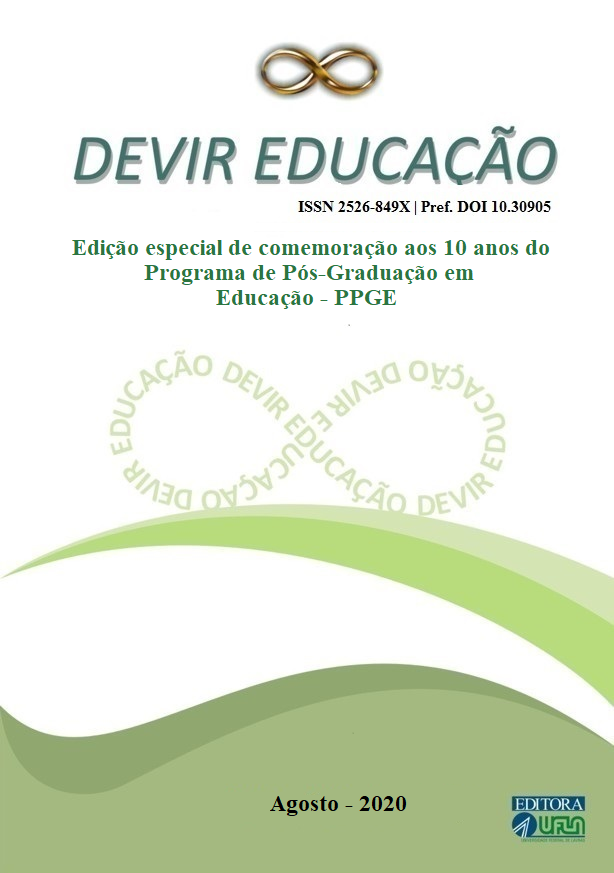The relationship between teaching and literature: a look at the dimension of action and teaching performance
DOI:
https://doi.org/10.30905/ded.v0i0.208Keywords:
Literary reading; Literary literacy; Reading strategies; Production of meanings; Professor-mediator.Abstract
Based on the enunciative-discursive dimension of language, this text considers written words as a form of expressiveness and dialogue between reader and text. Literary literacy is seen as a practice of appropriating literature as a language, of producing meanings, of literary experience, without being restricted to the school period, which occurs in different social instances. However, the school shows itself as a space for managing reader actions, which allows significant experiences with the literature. So, the purpose is to reflect on the relationship between teaching and literature, through an experience report of actions and practices that involve literary reading, performed in the classroom context. Based on the description of the experiences report, developed by a 2nd grade elementary school teacher, with children in the process of alphabetization, a reflexive analysis of literary reading actions is presented, supported by Cosson's propositions (2014; 2016), and other authors who discuss about the subject. Therefore, an approximation between theory and practice is sought, giving a new meaning to the role of literary reading in school, in order to enhance the role of the teacher as a mediator in the process of building new readers. As a result, it is highlighted that the changes regarding the pedagogical work with literary reading, developed by the teacher, were consistent with the fundamental characteristics emphasized on literary literacy by Cosson. From this reflection, it was found that actions and reading practices were proposed, which helped and encouraged the development of reading strategies by the child as reader.
Downloads
References
BAKHTIN, Mikhail. Estética da criação verbal. 4. ed. Trad. Paulo Bezerra. São Paulo: Martins Fontes, 2003.
______. Marxismo e filosofia da linguagem. Trad. Michel Lahud e Yara Frateschi Vieira. 13. ed. São Paulo: Hucitec, 2012.
BRAIT, Beth. Bakhtin e a natureza constitutivamente dialógica da linguagem. In: ______. (Org.). Bakhtin, dialogismo e construção de sentido. Campinas: Editora da Unicamp, 2005. p.87-98.
CANDIDO, Antonio. O direito à literatura. In: ___. Vários Escritos. 5 ed. Rio de Janeiro: Ouro sobre Azul/ São Paulo: Duas Cidades, 2011. p. 169-19.
COSSON, Rildo. Letramento literário. In: FRADE, Isabel C. Alves da Silva et al. Glossário CEALE: termos de alfabetização, leitura e escrita para educadores. Belo Horizonte: UFMG/Faculdade de Educação, 2014. p. 185-186.
COSSON, Rildo. Letramento literário: teoria e prática. 2.ed. São Paulo: Contexto, 2012.
DALCIN, Andrea Rodrigues. A leitura do livro ilustrado e livro imagem: da criação ao leitor e suas relações entre texto, imagem e suporte. IX ANPED Sul Seminário de Pesquisa em Educação da Região Sul. 2012.
GUEDES-PINTO, Ana Lúcia. Práticas de leitura: papel da formação continuada e seus impactos na alfabetização. In: GOULART, Ilsa do Carmo Vieira; MAZIERO, Maria das Dores Soares; CARVALHO, Silvia Aparecida Santos de (Org.). Leitura, escrita e alfabetização: a pluralidade das práticas. Campinas: Leitura Crítica, 2017. p. 96-105.
LAJOLO, Marisa Philbert. Usos e abusos da literatura na escola: Bilac e a literatura escolar na República Velha. Rio de Janeiro: Globo, 1982.
LAJOLO, Marisa. O texto não é pretexto. Será que não é mesmo? In: ZILBERMAN, Regina; RÕSING, Tania (Org.). Escola e leitura: velha crise, novas alternativas. São Paulo: Global, 2009. p. 99-112
LOBO, Dalva de Souza; GOULART. Ilsa do Carmo Vieira. O leitor e a leitura literária: do projeto à fruição. In: GOULART, Ilsa do Carmo Vieira; MAZIERO, Maria das Dores Soares; CARVALHO, Silvia Aparecida Santos de (org.). Leitura, escrita e alfabetização: a pluralidade das práticas. Campinas: Leitura Crítica, 2017. p. 122-137.
MELLO, S. A. Leitura e literatura na infância. In: GIROTTO, C. G. G. S.; SOUZA, R. J. de. Literatura e Educação Infantil: Livros Imagens e Práticas de Leitura. Campinas: Mercado das Letras, 2016. vol. 1. p.39-56.
PAIVA, Silvia Cristina Fernandes; OLIVEIRA, Ana Arlinda. A literatura infantil no processo de formação do leitor. Cadernos da Pedagogia, São Carlos, v. 4, n. 7, p. 22-36, jan./jun. 2010. Quadrimestral. Disponível em: http://www.cadernosdapedagogia.ufscar.br/index.php/cp/article/viewFile/175/101 Acesso em: 28 abr. 2020.
PIMENTEL, L. G.; CUNHA, E. J. L. da; MOURA, J. A. Propostas Curriculares – Arte para o ensino fundamental e para o ensino médio, 2006. Disponível em: http://crv.educacao.mg.gov.br/sistema_crv/index.aspx?&usr=pub&id_projeto=27&id_objeto=38680&id_pai=38679&tipo=txg&n1=&n2=Proposta%20Curricular%20-%20CBC&n3=Fundamental%20-%206°%20ao%209º&n4=Arte&b=s&ordem=campo3&cp=fc5e36&cb=mar Acesso em: 03 ago. 2019.
QUEIRÓS, Bartolomeu Campos de. Ler é deixar o coração no varal. In: QUEIRÓS, Bartolomeu Campos de. Sobre ler, escrever e outros diálogos. Belo Horizonte: Autêntica, 2012. p. 89-97.
ROJO, Roxane. Letramentos múltiplos, escola e inclusão social. São Paulo: Parábola Editorial, 2009.
SILVA, Maria de Jesus Marques. A literatura infantil como recurso para aquisição da linguagem da criança. In: ENCONTRO NACIONAL DE DIDÁTICA E PRÁTICAS DE ENSINO, 2012, Campinas. XVI ENDIPE. Campinas: Junqueira & Marin, 2012. p. 1-12. Disponível em: http://docplayer.com.br/165541303-Palavras-chaves-literatura-infantil-linguagem-oral-narrativas.html Acesso em: 28 abr. 2020.
SOARES, Magda. Letramento: um tema em três gêneros. 2. ed. Belo Horizonte: Autêntica, 1999. 128p.
______. A escolarização da literatura infantil e juvenil. In: EVANGELISTA, Aracy Alves Martins; BRANDÃO, Heliana Maria Brina; MACHADO, Maria Zélia Versiani (Org.). Escolarização da leitura literária. 2. ed. Belo Horizonte: Autêntica, 2011.
SOUZA, Renata Junqueira; COSSON, Rildo. Letramento Literário: uma proposta para a sala de aula. Objetos Educacionais, UNESP, n.15, p.101-107, ago. 2011. Disponível em: http://acervodigital.unesp.br/handle/123456789/40143 Acessado em: 04 jan. 2020.
SOLÉ, Isabel. Estratégias de leitura. Trad. Cláudia Schilling. 6. ed. Porto Alegre: Artmed, 1998.
STREET, Brian. Letramentos sociais: abordagens críticas do letramento no desenvolvimento, na etnografia e na educação. Trad. Marcos Bagno. São Paulo: Parábola Editorial, 2014.
ZILBERMAN, Regina. A leitura e o ensino da literatura. São Paulo: Contexto, 1988.
Downloads
Published
How to Cite
Issue
Section
License
A reprodução, total ou parcial, dos artigos aqui publicados fica sujeita à expressa menção da procedência de sua publicação, citando-se a edição e data dessa publicação. Para efeitos legais, deve ser consignada a fonte de publicação original.


